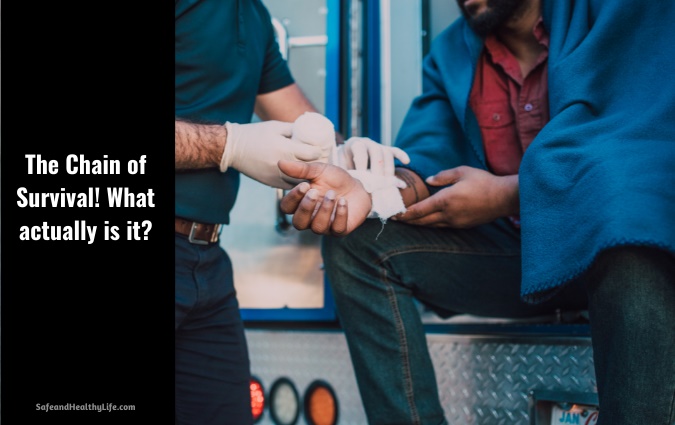The Chain of Survival! What actually is it?

You may or may not have heard of the chain of survival before, but do you actually know what it means?
We’ve compiled this post to share the fundamental basics of this to give you an understanding of what it is and how it works.
What is the chain of survival?
The chain of survival is essentially a series of events, aka a virtual chain that is taken in an attempt to save someone’s life who is experiencing a cardiac arrest.
The chain of survival is broken down into 4 key links, and it’s vital that not only first responders know this crucial chain but also bystanders.
The more people that know how to act in this situation, the more likely the patient will survive.
Why knowing the chain of survival links is so important
Most cardiac arrests occur outside of a hospital, and the survival rate is very low. Intervening early can significantly increase the person’s chances of survival.
During a cardiac arrest, the brain is deprived of oxygen, and irreversible tissue damage can occur within 6 minutes.
Administering CPR can buy the patient precious time by pumping oxygenated blood around the body until professional help arrives.
A breakdown of the links in the chain
- Recognising the early symptoms and signs of a cardiac arrest and calling emergency services
- Starting CPR immediately with an emphasis on the compressions
- Administering defibrillation early
- Early advanced life support
Below we’ll look at these 4 links more closely:
1. Early Access
Acting quickly when a cardiac arrest is occurring can be the difference between life and death and to be able to do this, you need to know how to identify the signs and symptoms. The best way you can do this is by completing CPR and first aid courses.
In this course, you’ll learn how to recognise when a patient is unconscious and not breathing, enabling you to alert emergency personnel quickly, or even better, get someone else who is present to do it so you can start CPR immediately, remembering the longer you wait or hesitate, the worse the outcome will likely be for the patient.
2. Early CPR
For the best chances of survival, CPR should start within 4 minutes of the person going into cardiac arrest, this means that adequate oxygen can be maintained in the brain and throughout the body. CPR should be continued until a defibrillator has arrived and can take over emergency services.
3. Early Defibrillation
When CPR is given promptly, ideally within the first four minutes and a defibrillator is used within 8 to 12 minutes, the chances of survival increase drastically. Every minute that passes without intervention, the less likely the patient is going to survive the event. To give you an idea of how important prompt action is, with every minute that passes, the chances of survival decrease by 9%. More businesses, community outlets, and workplaces are implementing defibrillators due to the significant lifesaving benefits they can provide.
4. Early Advanced Life Support
This last link in the chain of survival is the actions of the medical professionals. This involves administering lifesaving medication, stabilising the airway, and continuing compressions and the defibrillator for as long as necessary on the way to the hospital and when in care in the hospital.
All of the links in the chain of survival need to be done to increase the likelihood of someone making it through a life-threatening cardiac event such as this.
Recognising the early signs of a cardiac arrest
Being able to recognise the signs of a cardiac arrest enables you to act quickly and with confidence.
Here are some of the most common signs that someone is about to go into cardiac arrest:
Breathing Difficulties
Feeling fatigued and having difficulties with your breathing can be early signs of an impending cardiac event. If you are feeling extreme fatigue with breathing difficulties, seek medical care as soon as you can.
Excessive Sweating
Sudden excessive sweating without any obvious reason is another sign that you may be about to experience a cardiac event. Often the excess sweat is the body’s response mechanism to a blockage in the arteries. As the path is obstructed, the heart has to work much harder to pump blood around the body.
Indigestion And Vomiting
Digestive issues are a sign that your heart is struggling, early signs of a cardiac arrest include nausea and vomiting.
Chest Pains
One of the most common and obvious signs of cardiac arrest is chest pains. If you have chest pains and it spreads to the shoulders and arms, this may be a telltale sign that you may be about to suffer a cardiac arrest.
Pain and discomfort in the jaw and back
If you have sudden pain in your back, jaw, or both, it’s a good idea to seek medical advice as soon as you can.
Dizziness
Dizziness is a common symptom of cardiac arrest. Feeling disorientated, dizzy, and losing balance can all be symptoms.
These are some of the symptoms that may be experienced prior to a cardiac arrest, but it’s important to remember that some people get no symptoms, some people get some, and others get all.
We hope this post has been informative and you now have an idea of the chain of survival and what it is. If you are looking to do a CPR or first aid course, contact us here at Paradise First Aid.
About The Author:
Andy has been the director of Paradise First Aid since 2008 when he established the organization. Holding multiple diplomas and certificates in first aid and emergency services, Andy carries a myriad of skills in first aid management. Andy is an enthusiastic member of the First Aid Industry Reference Committee and the Australian Resuscitation Council. Andy is passionate about Professional Development and seeing people become fully equipped in their first aid training.

